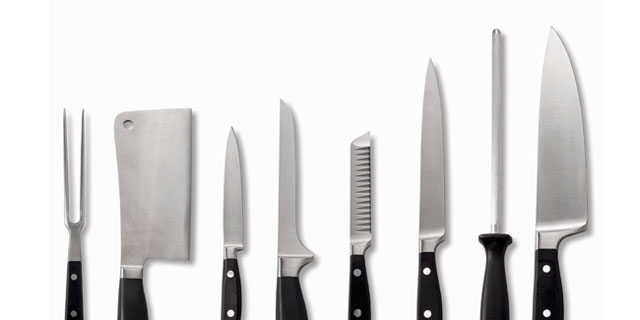You can’t be a great chef without the right tools and the most important of those tools is a good set of knives. Knives are vital, when you find the right ones you’ll suddenly find cooking is easier: chopping onions doesn’t make you cry, slicing through steaks is easier than slicing through butter, and you’ll be able to cut through bread and tomatoes without ripping them both to shreds.
Related: Knife Skills 101: How to Avoid Losing a Finger
But how do you buy the right ones? Do you need a serrated knife? What about a pairing knife? Ceramic or high carbon steel? Is there even a difference? Yes! So before you throw that knife block into your cart, read on for tips from Rachel Sherwood of Impressions Food Styling and chef Mark Estee of Camporeno on how to find and buy the right kitchen knives. [pagebreak]
The Lingo
There are four basic parts to a knife: the blade, the handle, the bolster, and the tang.
First up, the blade. The blade is usually made of one of four materials: stainless steel, carbon steel, high-carbon steel, or ceramic. Each one comes with its own set of pros and cons: stainless steel knives are inexpensive but can’t be sharpened once they’ve lost their edge; carbon steel knives will stay sharp through lots of wear and tear but they require more than just a rinse and they’ll eventually discolor; high carbon steel will stay sharp without discoloring but are a bigger investment; and ceramic knives will stay sharp the longest but they can break easily and aren’t flexible (you won’t be using this to de-pit an avocado!).
Next, the handle. The handle is usually made of one of four materials as well (wood, plastic, rubber, or metal) and can either be bolted or riveted to the blade or molded around the blade. While you’ll probably want to stay away from wood for sanitary reasons, you probably won’t decide on a knife based solely on the handle.
After the handle, there’s the bolster. This the area of the knife between the blade and the handle. And finally, there’s the tang, this is the part of the blade after the bolster that runs into the handle. And while both of these play a factor in price (the longer the tang, the heavier the knife, the pricier it is), it really doesn’t matter unless you’re doing some heavy duty knifework or practicing to become a butcher.
Next, how to buy the perfect knife for you… [pagebreak]
What Type of Knives Do You Need
Sure, buying a 42-piece set sounds appealing but just take a moment. Sherwood and Estee say first you should think about the types of knives you use.
“The three knives that will accomplish most cooking tasks are the paring knife, serrated knife, and chef’s knife,” Sherwood said.
Just in case that sounded foreign: paring knives are small knives used for small items like slicing veggies or fruit. Serrated knives are for slicing delicate items such as bread, cakes, and tomatoes. And a chef’s knife is the kitchen workhorse, it’s used for chopping and slicing everything from protein to veggies.
So think about the types of dishes you normally prepare and then choose appropriately. For what you cook and who’s using the knife.
“Remember all of these knives come in a variety of sizes,” Sherwood said. “You can get a 3-or 4-inch pairing knife or a 4-to-10-inch chef’s knife.” [pagebreak]
How To Pick The Right Knife
Just what is the right knife? Estee says you have to feel it. And not in some mythical sense: you actually need to feel it.
“Hold it, touch it, feel it. Does it feel good in your hand? Can you see yourself doing some work with it? If so then it’s the knife for you,” Estee said.
So take a field trip to your local kitchen goods store and take some for a test run.
“It should feel comfortable, balanced, and secure when you hold it,” Sherwood said. “Know that a knife is a personal choice and the proper knife for a 6-foot man is going to be a very different one from a 4-foot women.”
Which Knives To Buy
After you’ve felt the knifes, and know how much money you can spend, start with a good chef’s knife and then add on based on your needs. (The top picks are usually a different sized chef knife, a small paring knife, and a serrated knife.)
And consider whether you want a forged or stamped knife. Forged knives cost more but if cared for properly, last a lifetime. They, can, however, not go in the dishwasher. Stamped knives, on the other hand are lightweight, flexible, and cheap. Easily replaced, they are good for those on a tight budget.
Finally, think about buying knives with some history or if you’d like to pass your knives on. Your grandkids might be using these to carve a pernil.


![Making Mealtime Matter with La Familia: Easy Sofrito [Video]](https://thelatinkitchen.com/wp-content/uploads/2015/10/sofrito-shutterstock__0-500x383.jpg)
![Easy Latin Smoothies: Goji Berry Smoothie [Video]](https://thelatinkitchen.com/wp-content/uploads/2015/12/goji_berry-shutterstock_-500x383.jpg)
















![Fun and Fast Recipes: Fiesta Cabbage Salad [Video]](https://thelatinkitchen.com/wp-content/uploads/2015/11/fiesta_cabbage_slaw-shutterstock_-500x383.jpg)









